A Dynamic Simulation of the Immune System Response to Inhibit and Eliminate Abnormal Cells
Abstract
:1. Introduction
2. The Immune—Healthy Diet Model (IHDM)
2.1. Equilibrium Points
- 1
- Primary response stage: The immune system recognizes the appearance of abnormal cells in the tissue, immune cells start to grow, and ; this point is given by
- 2
- Interaction stage: The immune cells eliminate or inhibit the abnormal cells, this means at the end of the interaction. This point is given bywhere
- 3
- Recovery stage: Immune cells that are involved in the reaction tend to zero and all abnormal cells are substituted with normal cells. This point is represented by
2.2. Analysis Stability of Equilibrium Points
- 1.
- Stability of primary response stage- : Under the hypothesis of the IHDM, the immune system is able to protect the human body from developing diseases. This means that it responds directly in cases of emergency such as the appearance of abnormal cells in the tissue. The Jacobian (2) at equilibrium point is computed as:
- 2.
- Stability of interaction stage- : This stage describes the ability of the immune cells to inhibit and eliminate the abnormal cells to prevent them from progressing to cancer over many years. We consider the model as having a significant interaction if abnormal cells are dying or being inhibited by the immune cells. This means that parameter at . To examine the stability of equilibrium point we compute the Jacobian (2) at this point aswhere
- 3.
- Stability of recovery stage- : According to the physiological process, the number of immune cells which are involved in the interaction starts to reduce automatically after inhibiting and eliminating the abnormal cells. Furthermore, the normal cells divide and grow, taking the place of the removed abnormal cells. To examine the stability of this point, we compute the Jacobian at as follows:where
- The system has three equilibrium points;
- The system has two equilibrium points which are stable nodes, which shows that the immune system plays a pivotal role in protecting the human body from diseases.
- The system has only one equilibrium point which is an unstable saddle, which shows the interaction between the immune system and abnormal cells.
3. Immune-Unhealthy Diet Model (IUNHDM)
3.1. Equilibrium Points:
- Primary response stage: In this stage, the immune system recognizes abnormal cells as foreign; this point is represented by This is a similar equilibrium point to that of the IHDM.
- Coexistence stage: In this stage, the immune cells treat abnormal cells as normal cells; this point is represented by
- There was a response from the immune system but the immune cells did not become involved in the interaction because the immune system was weak, or;
- The immune cells became involved in the interaction but failed to inhibit or eliminate the abnormal cells. Hence, this type of interaction damages the immune cells. In other words, the population of before inhibiting or eliminating the abnormal cells.
3.2. Stability of Equilibrium Points
- 1.
- Stability of primary response stage: Since this point is identical to the primary response stage for the IHDM, we use (3) to examine the stability of this stage for the IUNHDM.
- 2.
- Stability of coexistence stage: This stage is considered to be a trigger for cancer because the immune cells die without inhibiting or eliminating the abnormal cells. This era of rapid development affecting our lifestyle, especially our dietary habits, is one of the main causes of abnormal cells progressing early into tumor cells. Since this is mathematically similar to the recovery point in the IHDM, the stability case is given by the following proposition:
4. Numerical Simulation
5. Conclusions
Author Contributions
Funding
Acknowledgments
Conflicts of Interest
References
- World Health Organization. World Health Statistics 2018: Monitoring Health for the SDGs Sustainable Development Goals; World Health Organization: Geneva, Switzerland, 2018. [Google Scholar]
- Bray, F.; Ferlay, J.; Soerjomataram, I.; Siegel, R.L.; Torre, L.A.; Jemal, A. Global cancer statistics 2018: GLOBOCAN estimates of incidence and mortality worldwide for 36 cancers in 185 countries. Cancer J. Clin. 2018, 68, 394–424. [Google Scholar] [CrossRef]
- Howard, P.; Whittaker, B. Placement Learning in Cancer & Palliative Care Nursing-E-Book: A Guide for Students in Practice; Elsevier Health Sciences: Philadelphia, PA, USA, 2012. [Google Scholar]
- Alberta, B.; Lewis, J.; Roberta, K.; Johnson, A.; Raff, M.; Walter, P. Molecular Biology of the Cell; Garland PUB: New York, NY, USA, 2008. [Google Scholar]
- Cooper, G.M.; Hausman, R.E. The Cell: A Molecular Approach; ASM Press: Washington, DC, USA, 2000; Volume 2. [Google Scholar]
- Boulet, L.P. Asthma and obesity. Clin. Exp. Allergy 2013, 43, 8–21. [Google Scholar] [CrossRef]
- Fung, T.T.; van Dam, R.M.; Hankinson, S.E.; Stampfer, M.; Willett, W.C.; Hu, F.B. Low-carbohydrate diets and all-cause and cause-specific mortality: Two cohort studies. Ann. Intern. Med. 2010, 153, 289–298. [Google Scholar] [CrossRef]
- Loeb, K.R.; Loeb, L.A. Significance of multiple mutations in cancer. Carcinogenesis 2000, 21, 379–385. [Google Scholar] [CrossRef] [PubMed]
- Pal, D.; Banerjee, S.; Ghosh, A.K. Dietary-induced cancer prevention: An expanding research arena of emerging diet related to healthcare system. J. Adv. Pharm. Technol. Res. 2012, 3, 16. [Google Scholar]
- Yusof, A.S.; Isa, Z.M.; Shah, S.A. Dietary patterns and risk of colorectal cancer: A systematic review of cohort studies (2000–2011). Asian Pac. J. Cancer Prev. 2012, 13, 4713–4717. [Google Scholar] [CrossRef] [PubMed]
- Yusof, A.S.; Isa, Z.M.; Shah, S.A. Perceptions of Malaysian colorectal cancer patients regarding dietary intake: A qualitative exploration. Asian Pac. J. Cancer Prev. 2013, 14, 1151–1154. [Google Scholar] [CrossRef]
- Shahar, S.; Shafurah, S.; Hasan Shaari, N.S.; Rajikan, R.; Rajab, N.F.; Golkhalkhali, B.; Zainuddin, Z.M.D. Roles of diet, lifetime physical activity and oxidative DNA damage in the occurrence of prostate cancer among men in Klang Valley, Malaysia. Asian Pac. J. Cancer Prev. 2011, 12, 605–611. [Google Scholar]
- Kuznetsov, V.A.; Makalkin, I.A.; Taylor, M.A.; Perelson, A.S. Nonlinear dynamics of immunogenic tumors: Parameter estimation and global bifurcation analysis. Bull. Math. Biol. 1994, 56, 295–321. [Google Scholar] [CrossRef] [PubMed]
- Kirschner, D.; Panetta, J.C. Modeling immunotherapy of the tumor–immune interaction. J. Math. Biol. 1998, 37, 235–252. [Google Scholar] [CrossRef]
- Mayer, H.; Zaenker, K.; An Der Heiden, U. A basic mathematical model of the immune response. Chaos Interdiscip. J. Nonlinear Sci. 1995, 5, 155–161. [Google Scholar] [CrossRef]
- Gałach, M. Dynamics of the Tumor—Immune System Competition—The Effect of Time Delay. Int. J. Appl. Math. Comput. Sci. 2003, 13, 395–406. [Google Scholar]
- Villasana, M.; Radunskaya, A. A delay differential equation model for tumor growth. J. Math. Biol. 2003, 47, 270–294. [Google Scholar] [CrossRef] [PubMed]
- Rihan, F.; Rihan, N. Dynamics of Cancer-Immune System with External Treatment and Optimal Control. J. Cancer Sci. Ther. 2016, 8, 257–261. [Google Scholar] [CrossRef]
- Bratus, A.; Samokhin, I.; Yegorov, I.; Yurchenko, D. Maximization of viability time in a mathematical model of cancer therapy. Math. Biosci. 2017, 294, 110–119. [Google Scholar] [CrossRef] [PubMed]
- Mufudza, C.; Sorofa, W.; Chiyaka, E.T. Assessing the effects of estrogen on the dynamics of breast cancer. Comput. Math. Methods Med. 2012, 2012, 473572. [Google Scholar] [CrossRef]
- Green, L.E.; Dinh, T.A.; Smith, R.A. An estrogen model: The relationship between body mass index, menopausal status, estrogen replacement therapy, and breast cancer risk. Comput. Math. Methods Med. 2012, 2012, 792375. [Google Scholar] [CrossRef] [PubMed]
- Ku-Carrillo, R.A.; Delgadillo, S.E.; Chen-Charpentier, B. A mathematical model for the effect of obesity on cancer growth and on the immune system response. Appl. Math. Model. 2016, 40, 4908–4920. [Google Scholar] [CrossRef]
- De Pillis, L.G.; Radunskaya, A. A mathematical tumor model with immune resistance and drug therapy: An optimal control approach. Comput. Math. Methods Med. 2001, 3, 79–100. [Google Scholar] [CrossRef]
- Ku-Carrillo, R.A.; Delgadillo-Aleman, S.E.; Chen-Charpentier, B.M. Effects of the obesity on optimal control schedules of chemotherapy on a cancerous tumor. J. Comput. Appl. Math. 2017, 309, 603–610. [Google Scholar] [CrossRef]
- Wu, J.; Tan, Y.; Chen, Z.; Zhao, M. Data Decision and Drug Therapy Based on Non-Small Cell Lung Cancer in a Big Data Medical System in Developing Countries. Symmetry 2018, 10, 152. [Google Scholar] [CrossRef]
- Alharbi, S.; Rambely, A.S. Stability Analysis of Mathematical Model on the Effect of Modern Lifestyles Towards the Immune System. J. Qual. Meas. Anal. 2018, 14, 99–114. [Google Scholar]
- Rosen, B.; Israeli, A.; Shortell, S. Accountability and Responsibility in Health Care: Issues in Addressing an Emerging Global Challenge; World Scientific: London, UK, 2012. [Google Scholar]
- Cairns, J. Cancer: Science and Society; WH Freeman: New York, NY, USA, 1978. [Google Scholar]
- Karacabey, K.; Ozdemir, N. The Effect of Nutritional Elements on the Immune System. J. Obes. Weight Loss Ther. 2012, 2, 152. [Google Scholar] [CrossRef]
- World Cancer Research Fund; American Institute for Cancer Research. Diet, Nutrition, Physical Activity and Cancer: A Global Perspective. 2018. Available online: https://www.wcrf.org/sites/default/files/Summary-third-expert-report.pdf (accessed on 1 August 2018).
- Rondanelli, M.; Faliva, M.A.; Miccono, A.; Naso, M.; Nichetti, M.; Riva, A.; Guerriero, F.; De Gregori, M.; Peroni, G.; Perna, S. Food pyramid for subjects with chronic pain: Foods and dietary constituents as anti-inflammatory and antioxidant agents. Nutr. Res. Rev. 2018, 31, 131–151. [Google Scholar] [CrossRef] [PubMed]
- Achadi, E.; Ahuja, A.; Bendech, M.A.; Bhutta, Z.A.; De-Regil, L.M.; Fanzo, J.; Fracassi, P.; Grummer-Strawn, L.M.; Haddad, L.J.; Hawkes, C.; et al. Global Nutrition Report: From Promise to Impact: Ending Malnutrition by 2030; International Food Policy Research Institute: Washington, DC, USA, 2016. [Google Scholar]
- Marwitz, S.E.; Woodie, L.N.; Blythe, S.N. Western-style diet induces insulin insensitivity and hyperactivity in adolescent male rats. Physiol. Behav. 2015, 151, 147–154. [Google Scholar] [CrossRef] [PubMed]
- Sample, C.H.; Martin, A.A.; Jones, S.; Hargrave, S.L.; Davidson, T.L. Western-style diet impairs stimulus control by food deprivation state cues: Implications for obesogenic environments. Appetite 2015, 93, 13–23. [Google Scholar] [CrossRef]
- Shaharudin, S.H.; Sulaiman, S.; Shahril, M.R.; Emran, N.A.; Akmal, S.N. Dietary changes among breast cancer patients in Malaysia. Cancer Nurs. 2013, 36, 131–138. [Google Scholar] [CrossRef] [PubMed]
- Park, Y.; Subar, A.F.; Hollenbeck, A.; Schatzkin, A. Dietary fiber intake and mortality in the NIH-AARP diet and health study. Arch. Intern. Med. 2011, 171, 1061–1068. [Google Scholar] [CrossRef]
- Tilg, H.; Moschen, A.R. Food, immunity, and the microbiome. Gastroenterology 2015, 148, 1107–1119. [Google Scholar] [CrossRef]
- Uranga, J.A.; López-Miranda, V.; Lombo, F.; Abalo, R. Food, nutrients and nutraceuticals affecting the course of inflammatory bowel disease. Pharmacol. Rep. 2016, 68, 816–826. [Google Scholar] [CrossRef]
- Newmark, H.L.; Yang, K.; Kurihara, N.; Fan, K.; Augenlicht, L.H.; Lipkin, M. Western-style diet-induced colonic tumors and their modulation by calcium and vitamin D in C57Bl/6 mice: A preclinical model for human sporadic colon cancer. Carcinogenesis 2008, 30, 88–92. [Google Scholar] [CrossRef] [PubMed]
- Hatami, M.; Esmaeil Akbari, M.; Abdollahi, M.; Ajami, M.; Jamshidinaeini, Y.; Davoodi, S.H. The relationship between intake of macronutrients and vitamins involved in one carbon metabolism with breast cancer risk. Tehran Univ. Med. J. TUMS Publ. 2017, 75, 56–64. [Google Scholar]
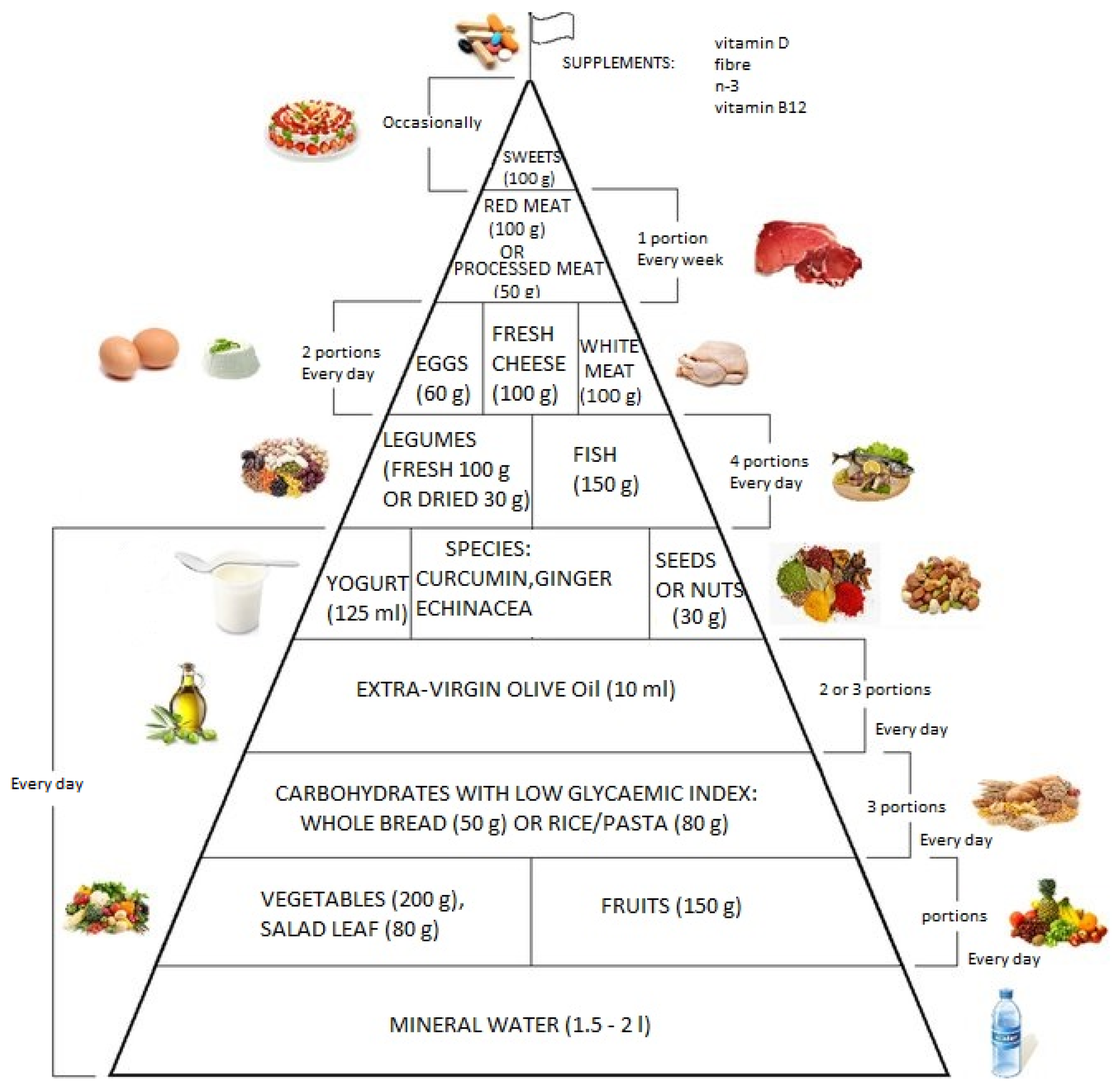

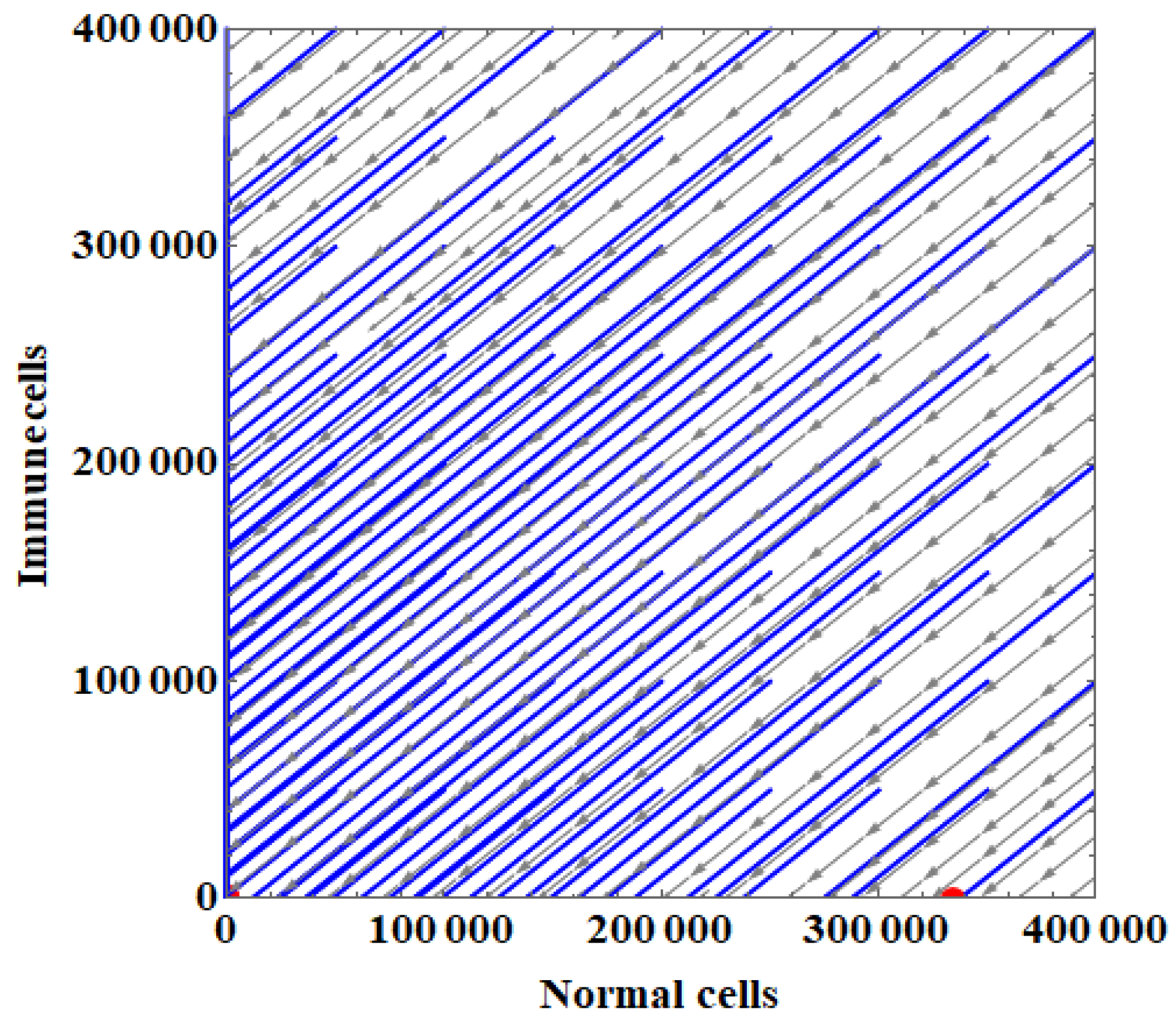
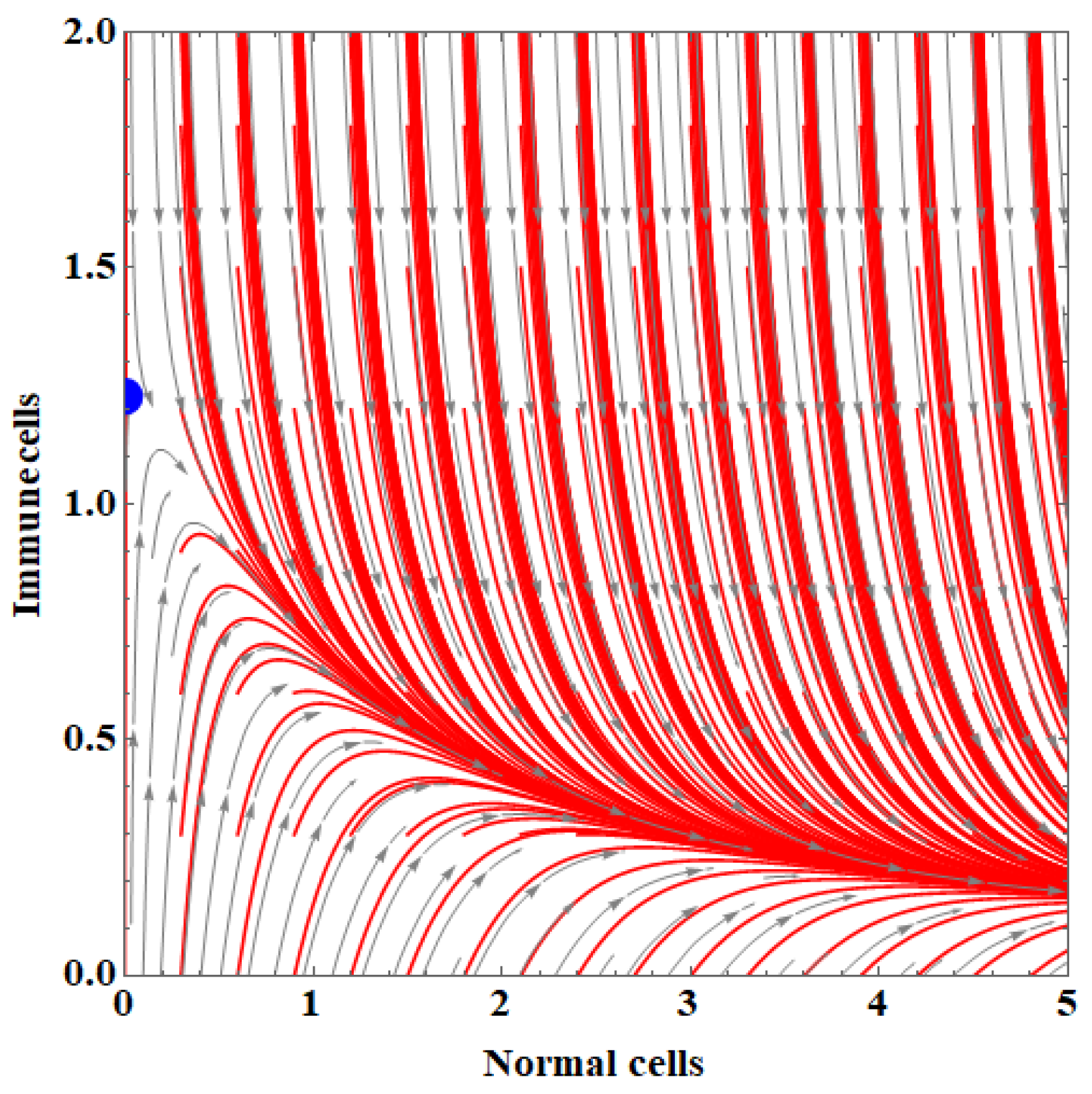
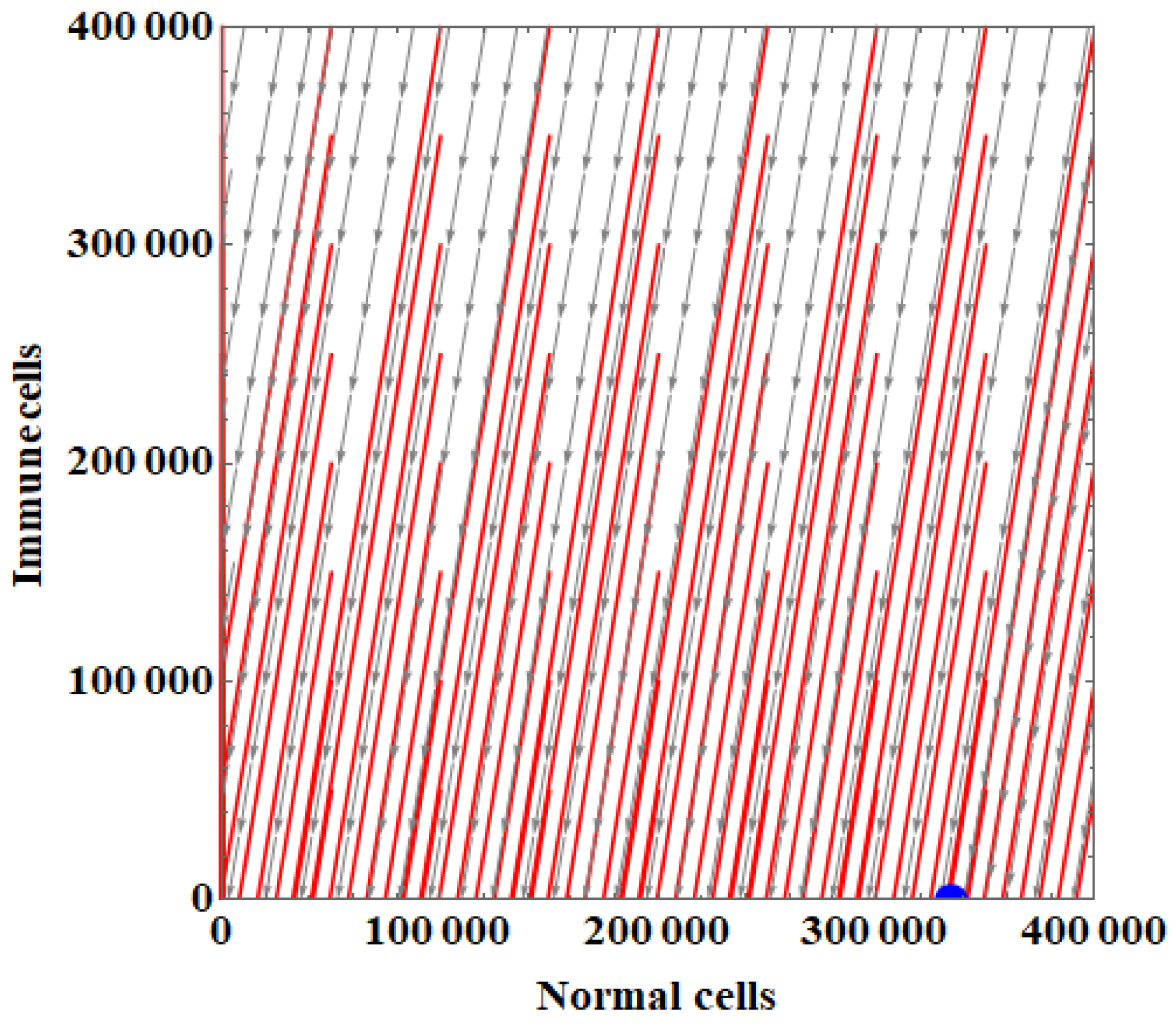
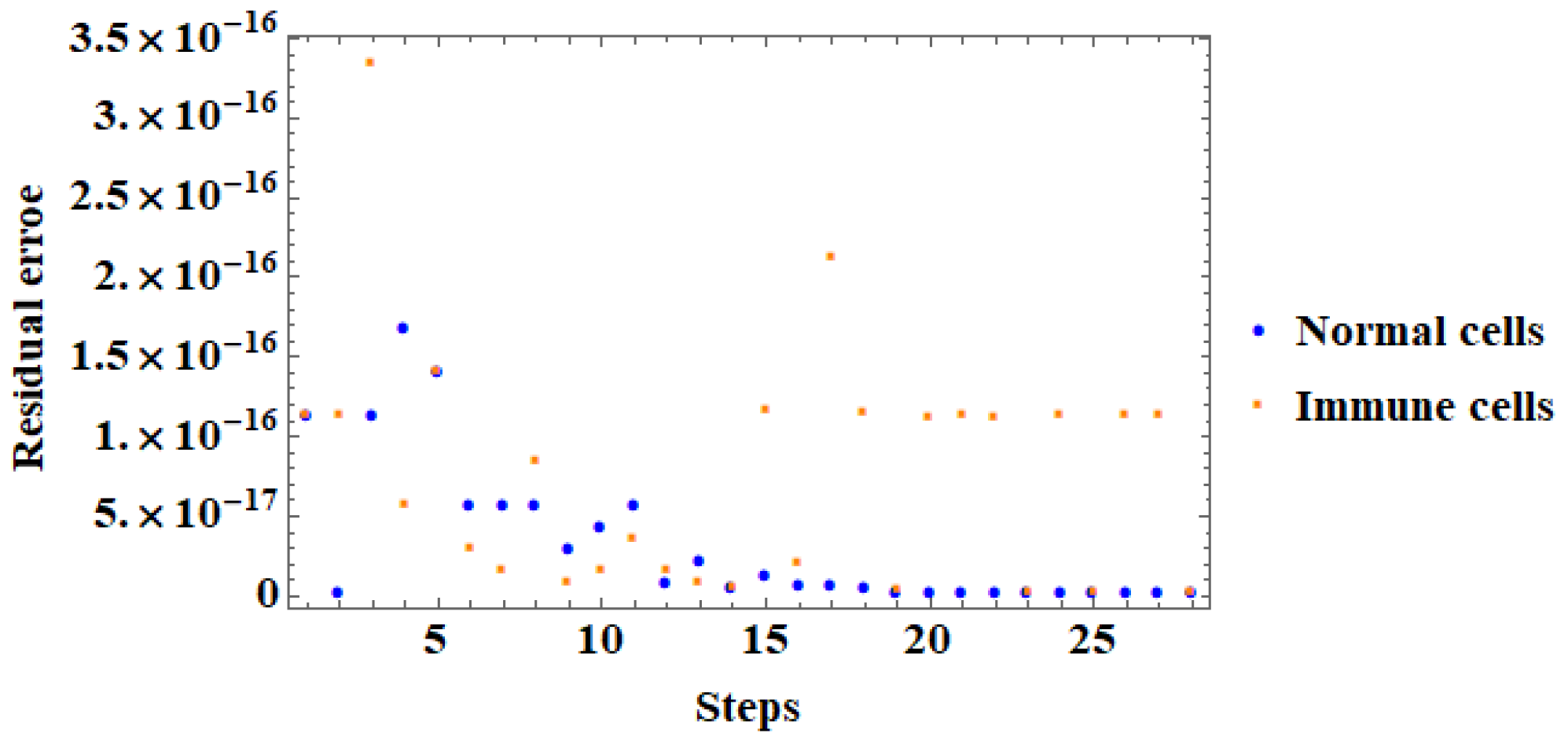
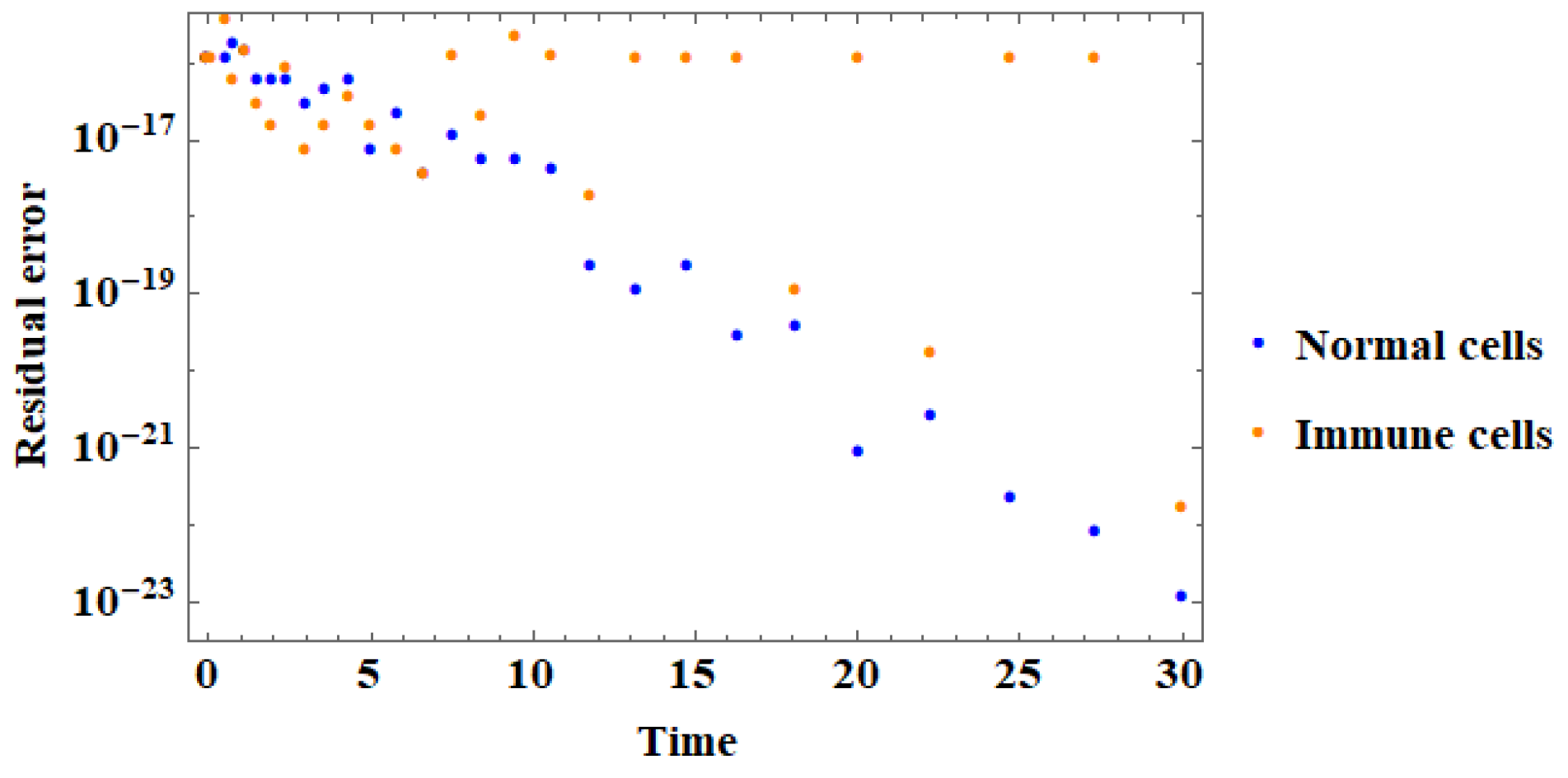
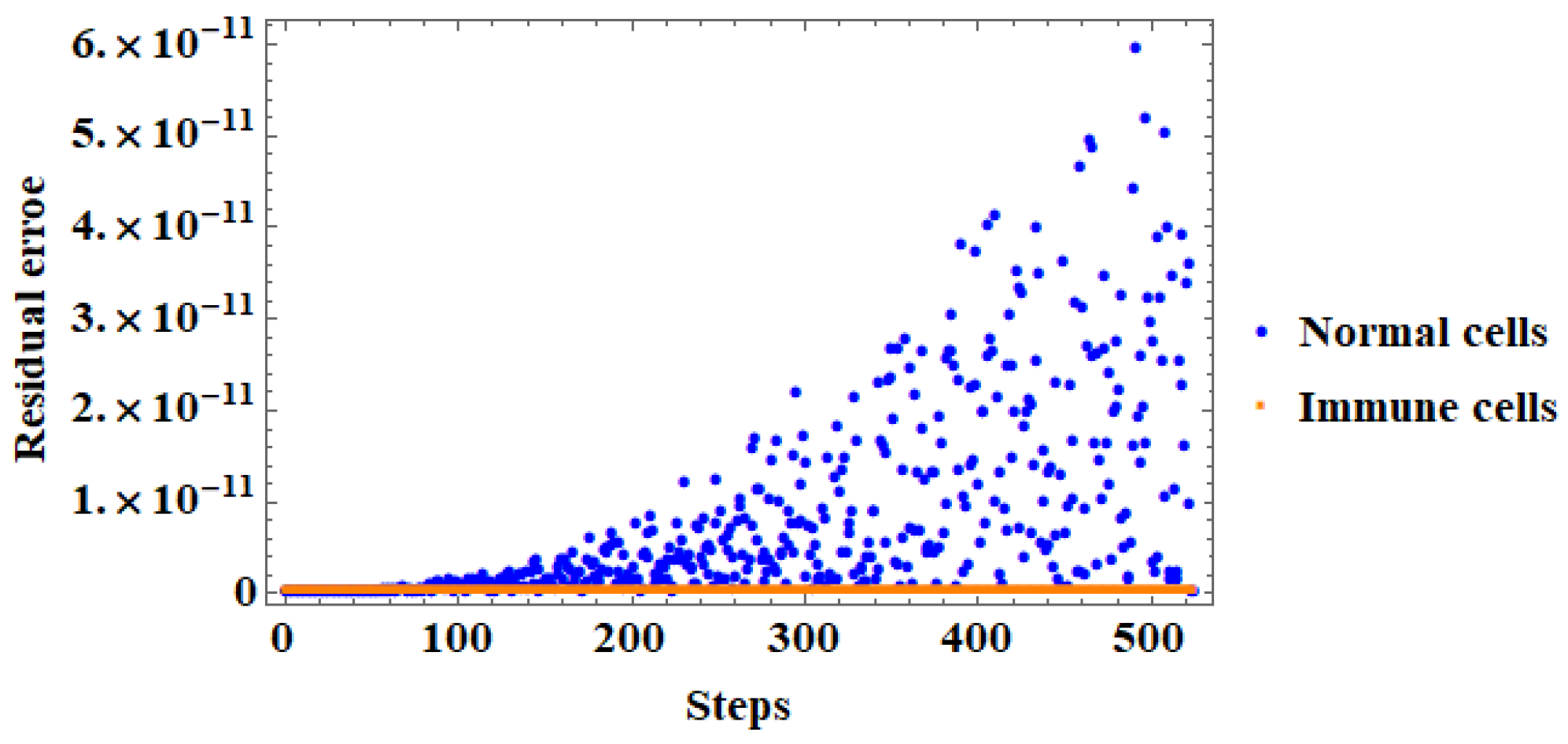
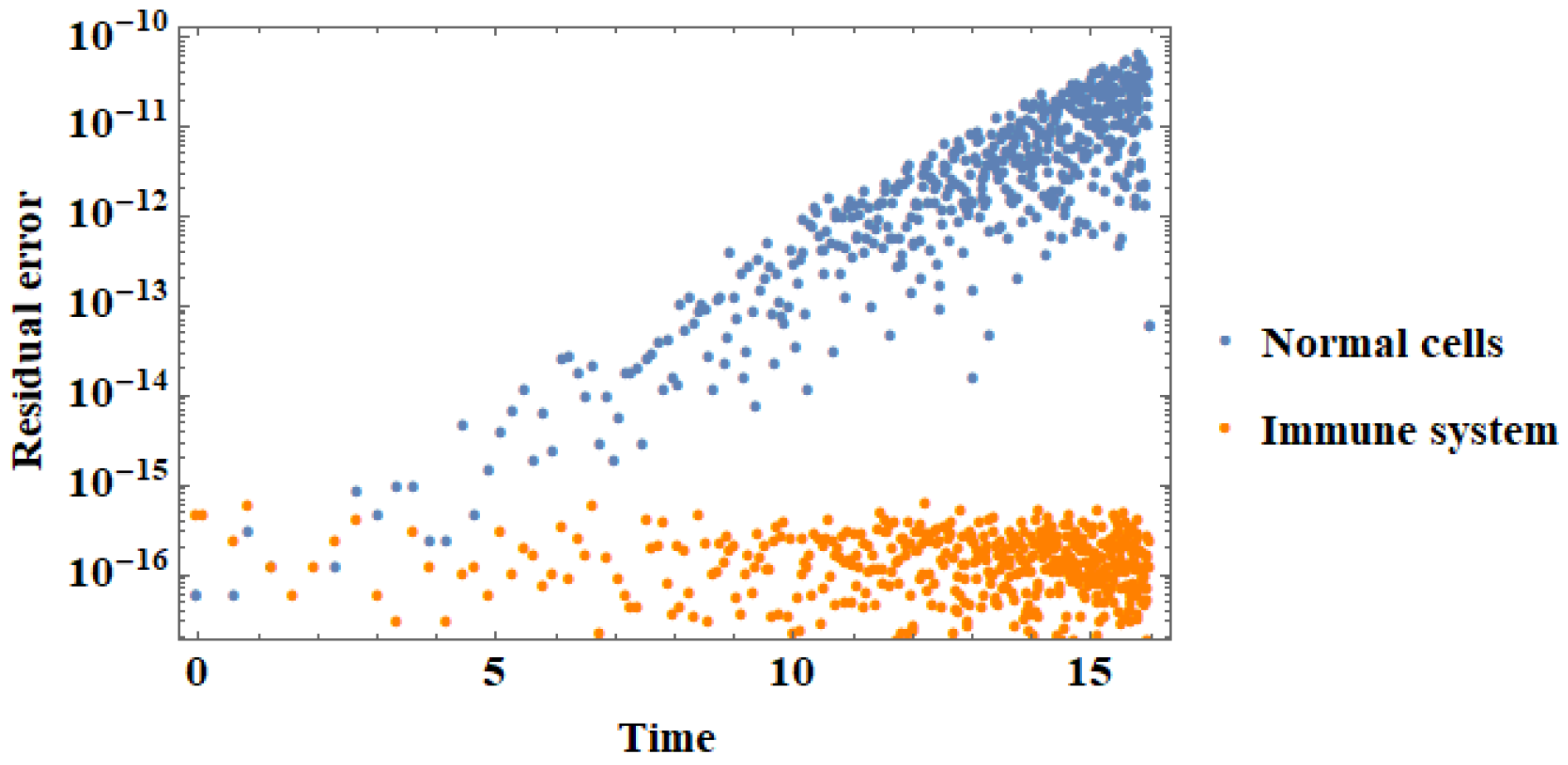
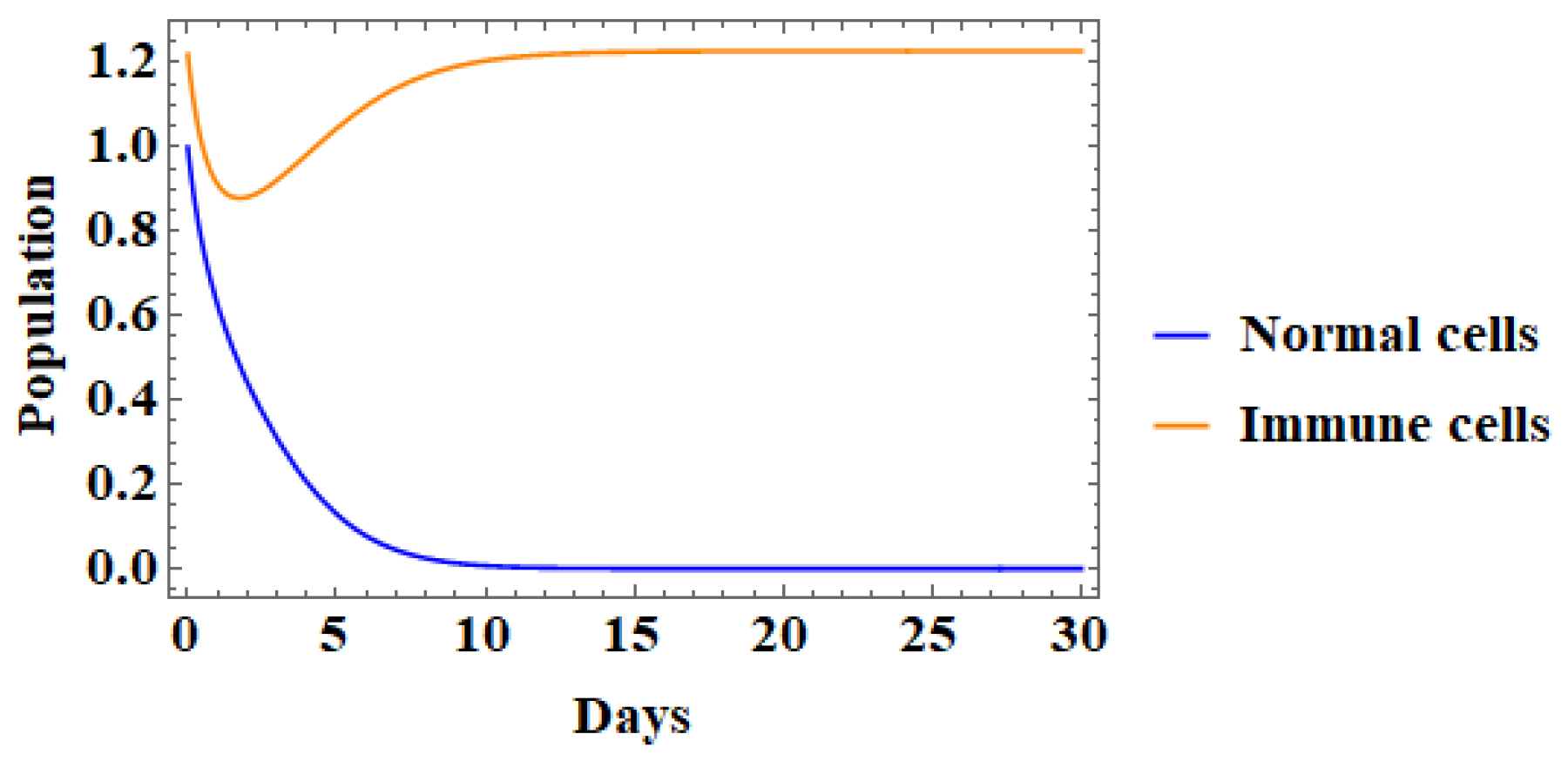
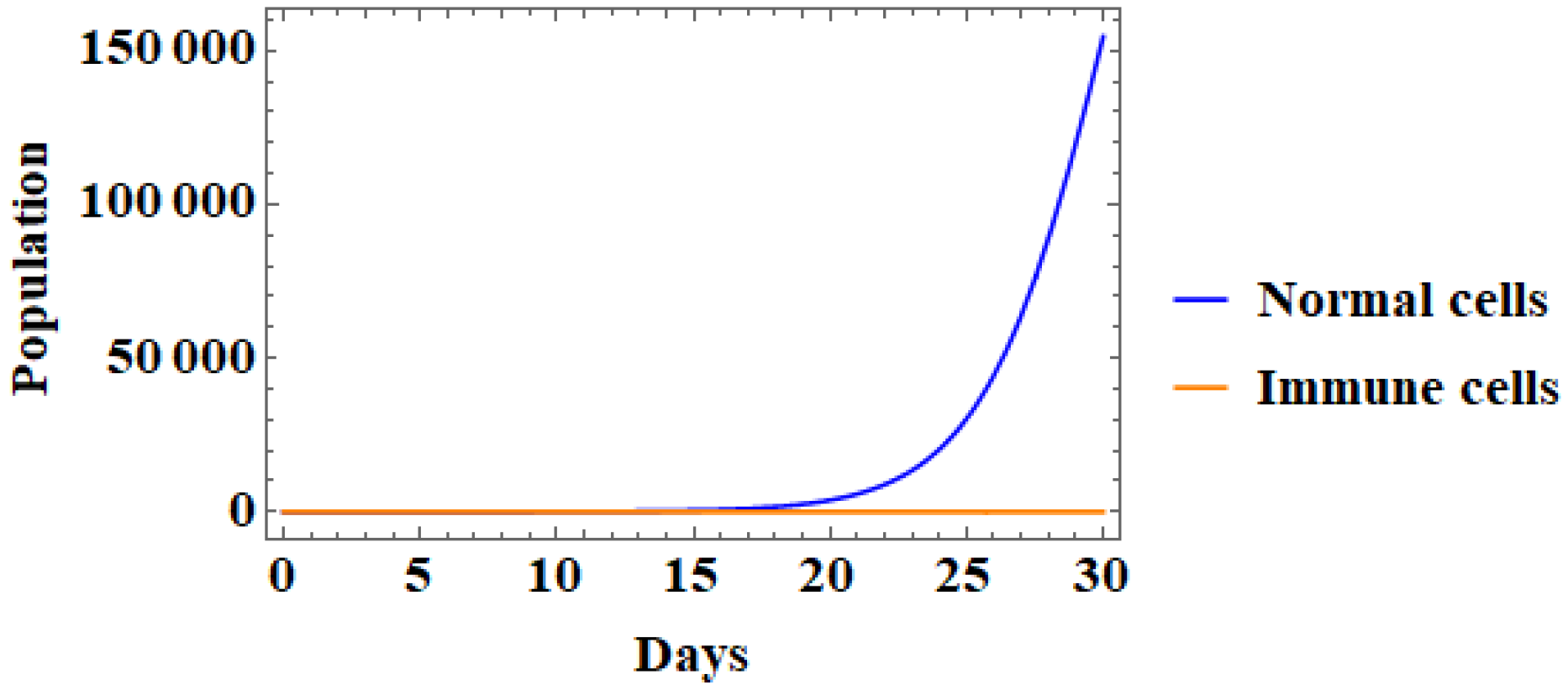
© 2019 by the authors. Licensee MDPI, Basel, Switzerland. This article is an open access article distributed under the terms and conditions of the Creative Commons Attribution (CC BY) license (http://creativecommons.org/licenses/by/4.0/).
Share and Cite
Alharbi, S.A.; Rambely, A.S. A Dynamic Simulation of the Immune System Response to Inhibit and Eliminate Abnormal Cells. Symmetry 2019, 11, 572. https://doi.org/10.3390/sym11040572
Alharbi SA, Rambely AS. A Dynamic Simulation of the Immune System Response to Inhibit and Eliminate Abnormal Cells. Symmetry. 2019; 11(4):572. https://doi.org/10.3390/sym11040572
Chicago/Turabian StyleAlharbi, S. A., and A. S. Rambely. 2019. "A Dynamic Simulation of the Immune System Response to Inhibit and Eliminate Abnormal Cells" Symmetry 11, no. 4: 572. https://doi.org/10.3390/sym11040572
APA StyleAlharbi, S. A., & Rambely, A. S. (2019). A Dynamic Simulation of the Immune System Response to Inhibit and Eliminate Abnormal Cells. Symmetry, 11(4), 572. https://doi.org/10.3390/sym11040572




